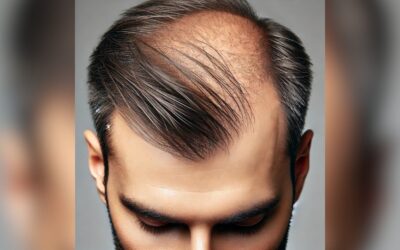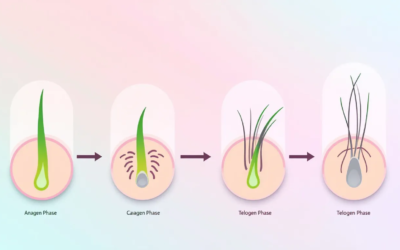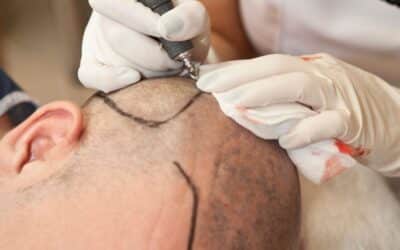Are hair transplants painful? This is a common question among those considering the procedure. While it’s true that there may be some discomfort associated with a hair transplant. This can be minimized by experienced surgeons and proper aftercare.
In this piece, we’ll look at what to anticipate when having a hair transplant and how to guarantee minimal distress both during and after the operation. We will also explore why one method of hair restoration might be more or less painful than another as well as the long-term results of successful procedures.
Table of Contents:
- What is a Hair Transplant?
- Pain During the Procedure
- Aftercare to Reduce Pain and Discomfort
- Long-Term Results of Hair Transplants
- FAQs in Relation to Are Hair Transplants Painful
- Conclusion
What is a Hair Transplant?

Hair transplants offer a lasting answer for hair loss, enabling patients to reestablish their customary hairline and accomplish a thicker head of locks. The procedure involves harvesting healthy follicles from the donor area (typically the back or sides of the scalp) and transplanting them into areas where there is thinning or baldness. FUE and FUT are the two primary techniques used for hair transplants, both of which involve taking healthy follicles from donor areas to be grafted into thinning or balding regions.
FUE Hair Transplants
Follicular Unit Extraction FUE involves removing individual follicles from the donor area one at a time using a small punch tool. These follicles are then carefully placed in tiny incisions made in areas with little or no existing hair growth. This technique offers minimal scarring, faster recovery times, and more precise results than traditional methods like FUT.
FUT Hair Transplants
FUT is an older method that involves removing a strip of skin from the donor area which contains several hairs bundled together as “follicular units”. These units are then divided up into individual grafts before being transplanted into areas with thinning or baldness on the scalp. While this method does offer slightly higher success rates than FUE, it can leave behind noticeable scars on both the donor site and recipient sites due to its invasive nature.
By undergoing a hair transplant, one can look forward to restoring confidence with natural-looking results that will last for years without any need for ongoing maintenance. This can also result in improved self-esteem as well as increased attractiveness due to the ability to style your locks again and reduced social anxiety from feeling embarrassed about having thin or bald patches on your head. With proper aftercare diligently followed through over time, you are sure to reap these rewards.

Risks of Hair Restoration Procedures
Despite these advantages, there are still some risks associated with undergoing such procedures. These include potential complications during the surgery itself, such as infection if not enough sterile precautions were taken beforehand, leading to further healing issues afterward. Depending on how deep the cuts were initially made, nerve damage may also occur.
Additionally, pain management strategies may not always be effective. Therefore, prior to deciding on a hair transplant procedure, it is essential to have an open and honest conversation with your surgeon about all potential outcomes.
Hair transplants can offer a lasting solution to hair thinning, with the potential for realistic outcomes. Pain levels during the procedure vary depending on the type of transplant chosen. This article will discuss FUE vs FUT pain levels as well as anesthesia and post-procedure discomfort management strategies.
Pain During the Procedure
When it comes to pain levels associated with hair transplants, there is a notable difference between FUE and FUT procedures. During an FUE transplant, patients typically experience only minimal discomfort. This is due to the fact that each follicular unit extraction (FUE) involves removing individual grafts from the donor area one at a time using tiny punches or blades.
On the other hand, during a strip procedure (FUT), patients may experience more discomfort because of the larger incision made in order to remove a strip of tissue from which multiple follicles can be harvested simultaneously.
Anesthesia and pain management techniques used during both types of hair transplants vary depending on patient preference and doctor recommendation. Local anesthesia is usually administered prior to beginning any type of hair transplant procedure in order to reduce discomfort for the patient throughout the entire process.
In addition, some physicians may also prescribe medications such as anti-anxiety drugs or muscle relaxants prior to the procedure in order to diminish any apprehension and tension that can cause increased sensitivity during treatment.
Aftercare to Reduce Pain and Discomfort
Medication for Post-Procedural Pain Relief:
Pain during the procedure can be managed with a variety of anesthesia and pain management techniques, allowing for minimal discomfort. With proper aftercare, patients can reduce post-procedure pain and swelling to ensure successful recovery from hair transplants.
Pain medication can be prescribed to help manage discomfort after a hair transplant procedure. Commonly prescribed medications include nonsteroidal anti-inflammatory drugs (NSAIDs) such as ibuprofen and acetaminophen, as well as narcotic pain relievers like codeine or hydrocodone. It is essential to adhere strictly to the dosage prescribed by your physician when taking any of these medications.
Self-Care Tips to Reduce Discomfort and Swelling:

After a hair transplant procedure, it is important to follow your surgeon’s instructions regarding activity level and self-care in order to reduce swelling and discomfort. Steer clear of strenuous activities, such as exercise, lifting heavy items, or any other form of physical exertion to help keep the inflammation in check during healing. Additionally, applying cold compresses can also help reduce swelling at the site of the surgery.
If severe pain that doesn’t answer to OTC medications or infection appears at the surgical site. You must contact your doctor straight away for extra help. In addition, any signs of bleeding from the donor sites or grafts should also be reported promptly so that proper medical attention can be provided if necessary.
Proper aftercare is essential to ensure that the pain and discomfort experienced during a hair transplant procedure are minimized. Therefore, prior to undergoing a hair transplant procedure, it is important to gain an understanding of the potential long-term outcomes.
Long-Term Results of Hair Transplants
When pondering a hair transplant, it is vital to comprehend the potential long-term effects. Generally, most people will begin to see initial results within three months after their procedure. However, the full effects of a hair transplant may not be seen for up to 12 months or longer. It is essential that patients follow their surgeon’s post-operative instructions and maintain regular follow-up visits with their doctor in order to achieve optimal results from the procedure.
To ensure your new locks remain robust and vigorous in the long run, it is imperative to adhere to certain maintenance protocols. This includes steering clear of activities such as swimming or sunbathing for a minimum of two weeks post-surgery. Utilizing mild shampoos, donning hats when outdoors, consuming a balanced diet abundant with vitamins A, B12, and C exercising habitually. Also, obtaining enough shut-eye each night and taking any prescribed medications as directed by your physician.
FAQs in Relation to Are Hair Transplants Painful
Is hair transplant permanently painful?
Hair transplantation is commonly thought of as a lasting fix for baldness, though some people may require several operations over time. While the procedure itself is not painful, there can be discomfort associated with it due to the numbing injections and post-operative swelling or soreness. Nevertheless, the majority of people find that any discomfort is usually minor and can be alleviated with over-the-counter medications.
Is anesthesia for a hair transplant painful?
No, anesthesia for a hair transplant is not painful. Anesthesia is used to ensure that the patient feels no discomfort during the procedure and remains relaxed throughout. A local anesthetic numbs the scalp area where incisions are made, while a general anesthetic can be used if desired. Anesthesia selection is based on individual needs and medical history. It should not cause any discomfort or suffering.
How many days of pain will be there after a hair transplant?
The pain after a hair transplant procedure varies from person to person. Generally, most patients experience mild discomfort in the donor and recipient areas for up to 3 days following their surgery. However, this can be managed with over-the-counter pain medications or prescription medication if needed. In certain cases, the scalp may swell up to 10 days after the surgery, yet this isn’t always seen. Most people are able to return to work within 1 week of their procedure and resume normal activities shortly thereafter.
What is the downside of a hair transplant?
Hair transplants may be a viable solution for thinning hair. However, there are certain drawbacks to consider. The procedure can be costly and may not provide the desired outcome. Furthermore, it might necessitate a lengthy healing period that could result in swelling, itching, scarring, or infection.
Additionally, the new hair follicles may not grow as thick or full as natural hair would have grown had no balding occurred. Finally, even if successful initially, over time the newly implanted hairs could still become affected by age-related thinning or other causes of hair loss.

Conclusion
Hair transplants are a permanent solution to hair loss and can provide natural-looking results. Although there is some discomfort during the procedure, it should not be overly painful with proper anesthetic techniques used by experienced surgeons.
With careful aftercare instructions from your surgeon, any postoperative pain or discomfort should be minimal as well. Before committing to a hair transplant, weigh the potential risks and benefits to ensure that it is the best choice for your specific needs.
If you are considering a hair transplant, take the time to research and understand the procedure so that you can make an informed decision. Talk to your doctor about any potential pain or discomfort associated with the process.
Best Hair Transplant
1970 S. Prospect Ave., Suite 2
Redondo Beach, CA 90277
(213) 403-0455
https://www.google.com/maps?cid=9280610872186794918










